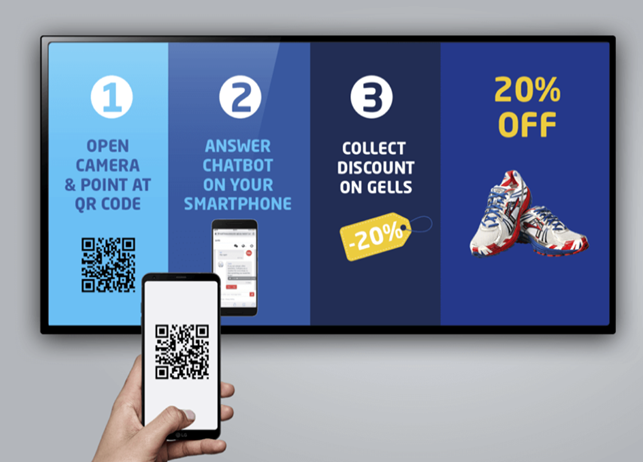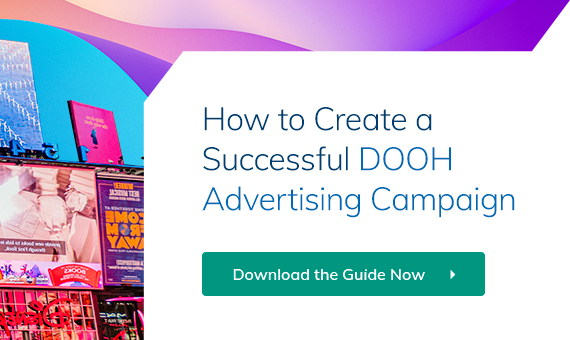Out-of-Home marketing or OOH marketing is a blanket term that covers any kind of advertising that a consumer encounters outside of their home. This can range from larger format displays such as billboards or street furniture, to smaller scale, more intimate promotions like interactive touch screens in a grocery store, or advertising installations at gyms and coffee shops.
Out-of-home marketing remains one of the most powerful ways to reach consumers in the physical world, providing high-impact, non-skippable visibility in high-traffic locations.
According to a TouchPoint report by IPA, OOH advertising reaches over 90% of adults every week – more than any other media channel. However, static billboards and printed posters come with significant limitations – from long production lead times to the lack of real-time audience insights.
This is where digital out-of-home marketing (DOOH) changes the game. By combining the physical presence of OOH with the precision of digital advertising, DOOH enables agencies to deliver dynamic, data-driven campaigns that target the right audience at the right time.
Beyond this, with programmatic DOOH (pDOOH), agencies can optimize ad placements in real time, measure audience engagement, and seamlessly integrate OOH into omnichannel strategies.
Learn more: How Does Programmatic DOOH Work?
For agencies looking to future-proof their advertising strategies, DOOH is no longer optional – it’s essential.
In this guide, we’ll explore the competitive advantages of DOOH, how it complements digital marketing efforts, and how agencies can leverage pDOOH to maximize client success.
The Competitive Edge of Digital Out of Home Marketing
While traditional out-of-home marketing has long been valued for its widespread reach and high-impact visibility, it comes with limitations. Static billboards and posters require long production times, lack real-time adaptability, and offer limited audience insights – making it difficult for agencies to track performance and optimize campaigns effectively.
Digital out-of-home marketing eliminates these challenges, transforming OOH into a flexible, data-driven channel that enhances audience targeting and campaign performance. By replacing static placements with dynamic digital screens, agencies can create smarter, more engaging campaigns that deliver real-time impact.
Why DOOH Outperforms Traditional OOH
1. Dynamic, High-Impact Visuals
DOOH brings advertising to life with motion graphics, video content, and interactive elements, making campaigns more engaging and attention-grabbing than static billboards. The ability to use animation, dynamic text, and real-time updates helps brands stay relevant and stand out in crowded urban environments.
For example, a retail brand launching a flash sale can update digital billboards instantly to reflect the latest discounts – something impossible with traditional OOH.
2. Real-Time Targeting & Contextual Relevance
One of the biggest drawbacks of traditional OOH is the inability to change messaging based on audience behavior or external conditions. With DOOH, agencies can use real-time data to trigger ads based on factors such as location, weather, time of day, or live events.
A coffee brand, for instance, can use programmatic DOOH to display hot coffee ads on chilly mornings and switch to iced drinks in the afternoon, maximizing relevance and consumer engagement.
3. Programmatic Buying for Greater Efficiency
Traditional OOH ad placements involve lengthy negotiations with media owners and fixed contracts, which can limit flexibility. DOOH, on the other hand, enables programmatic ad buying, allowing agencies to automate placements, bid in real time, and adjust campaigns on the fly.

(Image source: google.com)
For instance, a travel agency, could bid for DOOH placements in airports and transit hubs during peak vacation seasons and shift spending dynamically based on traveler activity and booking trends.
4. Actionable Data & Measurable ROI
Unlike static billboards, which provide limited audience insights, DOOH campaigns are measurable and data driven. With advanced analytics, agencies can track:
- Impressions– How many people were exposed to an ad.
- Dwell Time– How long viewers remained near a DOOH screen.
- Engagement Metrics– Interactions via QR codes, mobile retargeting, or social media.
This enables agencies to continuously optimize campaigns based on real performance data, ensuring ad spend is allocated effectively.
How Digital Out-of-Home Marketing Complements Other Digital Strategies
In today’s multi-channel advertising landscape, agencies must ensure that their campaigns create seamless brand experiences across both online and offline touchpoints. Digital out-of-home marketing plays a crucial role in this strategy, reinforcing brand messages beyond personal devices and into the physical world.
According to industry research, 91% of advertisers believe DOOH delivers both upper and lower funnel metrics, making it a powerful driver of brand awareness and direct response marketing. By integrating DOOH with digital marketing efforts, agencies can extend their reach, enhance engagement, and drive measurable results across multiple platforms.
1. Extending Digital Reach into the Real World
While digital advertising is essential, online ads alone aren’t enough to capture consumer attention in a fragmented media landscape. DOOH expands digital campaigns into public spaces, reaching audiences during their daily routines – whether they’re commuting, shopping, or socializing.
A fashion retailer running a seasonal online campaign can use DOOH billboards in shopping malls to reinforce messaging and drive foot traffic to physical stores. This omnichannel approach ensures that brand exposure isn’t limited to just social media or search ads.
2. Retargeting & Cross-Channel Engagement
DOOH isn’t just a one-way communication tool – it can directly enhance digital ad performance through mobile retargeting and cross-channel tracking. Agencies can sync DOOH ads with mobile devices, social media, and ecommerce platforms, creating multiple consumer touchpoints that drive conversions.
For example, a travel brand running a DOOH campaign at an airport can retarget travelers with mobile ads and personalized offers once they return to their devices – leading to higher engagement and booking rates.
3. Strengthening Brand Recall & Message Consistency
Consumers are more likely to engage with a brand when they see consistent messaging across multiple platforms. By aligning DOOH creatives with social media, video ads, and website content, agencies can reinforce brand identity and increase recall rates.
A tech company launching a new smartphone can sync DOOH displays with its YouTube pre-roll ads and influencer marketing campaigns, ensuring potential customers encounter a unified brand message across multiple channels.
4. Driving Online Actions from Offline Interactions
DOOH campaigns can include interactive elements like QR codes, NFC (Near Field Communication) technology, or social media hashtags – encouraging consumers to take action immediately. This bridges the gap between offline exposure and digital engagement, making it easier for brands to convert interest into action.

[Image source: google.com]
A sportwear brand, for example, can display DOOH ads with limited-time promo codes, prompting pedestrians to scan and order directly from their phones, creating instant conversions from physical-world interactions.
Why Agencies Must Embrace DOOH Now
As digital advertising evolves, digital out-of-home marketing has become essential for agencies looking to enhance brand visibility, improve audience targeting, and drive measurable results. By combining the reach of traditional OOH with the precision of digital advertising, DOOH enables agencies to create dynamic, data-driven campaigns that engage consumers in the real world.
With real-time content updates, programmatic ad buying, and seamless integration with digital marketing, DOOH empowers agencies to deliver more impactful and cost-effective campaigns for their clients.
To unlock the full potential of DOOH, agencies need a powerful, programmatic platform that ensures precision, efficiency, and real-time optimization. The Neuron’s AI-powered pDOOH platform simplifies campaign management, enhances audience targeting, and provides seamless access to premium digital inventory, worldwide.
Ready to take your agency’s campaigns to the next level? Discover how The Neuron can help you leverage DOOH for smarter, more impactful advertising. Get in touch today.

